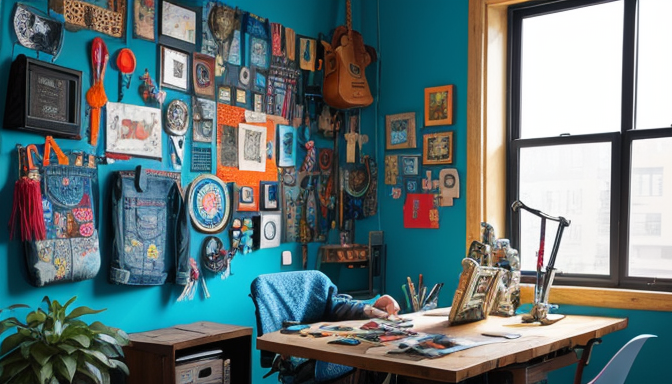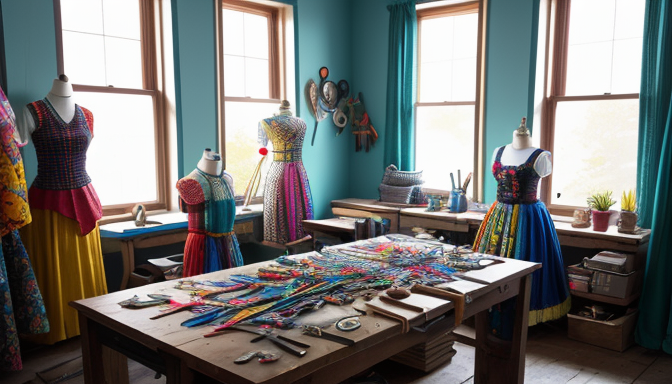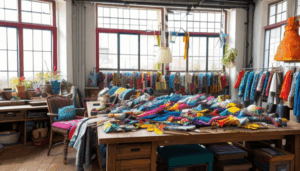In a world where fashion trends seem to change at lightning speed, upcycling clothes has emerged as a refreshing breath of fresh air. Why is this movement gaining so much traction? Well, for starters, it’s not just about giving your old clothes a new lease on life; it’s about making a statement. Upcycling allows us to take a stand against the environmental impact of fast fashion, which is notorious for its pollution and waste. By transforming discarded garments into unique pieces, we’re not only reducing waste but also embracing our creativity.
Imagine walking into a party wearing a one-of-a-kind outfit that you crafted yourself. That’s the beauty of upcycling! It’s an opportunity to showcase your personal style while contributing to a more sustainable future. This trend is like a canvas waiting for your artistic touch, where the only limit is your imagination. Plus, it’s incredibly satisfying to wear something that you’ve transformed from something old into something fabulous.
But it doesn’t stop there. Upcycling also has economic benefits that are hard to ignore. It encourages individuals to engage in DIY projects and supports local artisans and small businesses. By fostering a circular economy, we can create job opportunities and stimulate our communities. This shift in consumer attitudes towards fashion is not just a fleeting trend; it’s a movement that prioritizes ethical choices and sustainability.
So, are you ready to dive into the world of upcycling? Whether you’re a seasoned crafter or just starting out, the journey is filled with endless possibilities. Embrace the challenge, let your creativity flow, and join the revolution that’s reshaping the fashion landscape!
The Environmental Impact of Fast Fashion
Fast fashion is like a whirlwind of trends that sweeps us off our feet, but have you ever stopped to think about what happens behind the scenes? It’s a shocking reality that the fashion industry is one of the largest polluters in the world. Each year, millions of tons of clothing are produced, only to be discarded shortly after. This cycle not only clogs our landfills but also contributes to significant environmental degradation.
The environmental footprint of fast fashion is staggering. To put it into perspective, consider the following:
- Over 92 million tons of textile waste is generated annually.
- It takes about 2,700 liters of water to make just one cotton shirt, enough for one person to drink for over 2.5 years.
- Fast fashion contributes to 10% of global carbon emissions, a figure that rivals the emissions from all international flights and maritime shipping combined.
These numbers highlight the urgent need for change. Upcycling clothes not only helps to reduce waste but also promotes a more sustainable approach to fashion. By transforming old garments into new creations, we can significantly lessen our environmental impact. Imagine turning a worn-out pair of jeans into a stylish bag or a faded t-shirt into a trendy crop top. Not only does this practice breathe new life into items that would otherwise end up in the trash, but it also fosters a culture of creativity and innovation.
As consumers, we have the power to shift the narrative. By choosing upcycled fashion, we are making a statement against the wastefulness of fast fashion. Every small step counts, and together, we can make a significant difference in reducing our ecological footprint while still looking fabulous!

Creative Expression Through Upcycling
Upcycling isn’t just about saving the planet; it’s also a vibrant canvas for your creativity! Imagine taking an old pair of jeans and transforming them into a trendy bag or turning a vintage dress into a chic top. This process allows you to showcase your artistic flair while making a statement about sustainability. When you upcycle, you’re not just recycling; you’re breathing new life into materials that would otherwise end up in a landfill.
Think about it: every old garment carries a story. By upcycling, you’re not just giving it a new purpose; you’re also adding your own unique narrative. It’s like being a fashion alchemist, turning the mundane into something magical. Whether you’re a seasoned DIY enthusiast or just starting out, the possibilities are endless. You can mix and match fabrics, experiment with colors, and even incorporate different techniques like embroidery or fabric painting.
Moreover, upcycling encourages a community of like-minded individuals who share tips, techniques, and inspiration. Online platforms and social media have become bustling hubs for upcyclers to showcase their creations, fostering a sense of belonging and collaboration. You might even find yourself joining challenges or workshops that push your creative boundaries!
To get started, consider these key aspects:
- Choose Your Materials: Look through your closet for items that you no longer wear. Think creatively about how they can be repurposed.
- Research Techniques: There are countless tutorials online that can help you learn new skills, from sewing to dyeing fabrics.
- Be Bold: Don’t be afraid to experiment. Sometimes the best creations come from taking risks!
In essence, upcycling is not just a trend; it’s a movement that celebrates individuality and creativity. So why not dive in? Your next masterpiece is waiting to be discovered in that pile of old clothes!
Economic Benefits of Upcycling
Upcycling isn’t just a creative outlet; it also brings significant economic benefits to individuals and communities alike. Imagine turning an old pair of jeans into a trendy bag or a vintage dress into a chic top. Not only does this save money, but it also fosters a sense of community empowerment and supports local economies. By embracing upcycling, we are not only reducing waste but also stimulating economic growth.
One of the most compelling aspects of upcycling is its potential to create job opportunities. As more people engage in DIY projects and start their own small businesses, the demand for upcycled products increases. This shift contributes to a circular economy, where resources are reused and repurposed, minimizing the need for new materials. For instance, local workshops and craft fairs are thriving as artisans showcase their upcycled creations, attracting customers who value sustainability.
Moreover, upcycling can lead to substantial savings for consumers. Instead of purchasing brand-new clothing, individuals can breathe new life into their existing wardrobe. This not only saves money but also encourages a mindful approach to fashion consumption. When you think about it, why spend a fortune on fast fashion when you can transform something old into something fabulous?
In essence, the economic benefits of upcycling resonate far beyond individual savings. They ripple through communities, creating jobs, supporting local artisans, and fostering a culture of sustainability. So, the next time you think about tossing out an old garment, consider the potential it holds—not just for your closet, but for your community’s economy as well.

Changing Consumer Attitudes Towards Fashion
In recent years, we’ve witnessed a significant shift in consumer attitudes towards fashion. More and more people are waking up to the harsh realities of the fashion industry, particularly the environmental and ethical implications of fast fashion. Have you ever thought about where your clothes come from? Many consumers are now asking these crucial questions, leading to a growing demand for sustainable alternatives.
This change in mindset is not just a passing trend; it’s a movement that emphasizes the importance of ethical fashion choices. With the rise of social media and eco-conscious influencers, individuals are increasingly aware of the impact their purchases have on the planet. It’s like a ripple effect—one person chooses to buy upcycled clothing, and suddenly, their friends want to know more. It’s a powerful way to spread awareness and encourage others to think twice before buying into the fast fashion cycle.
Moreover, many consumers are now prioritizing quality over quantity. Instead of filling their wardrobes with countless cheap items, they are opting for fewer, high-quality pieces that will last longer. This shift not only promotes sustainability but also encourages a deeper appreciation for craftsmanship and uniqueness in fashion. The idea of owning something that tells a story or has been given a new life resonates with many, making upcycled clothing a desirable option.
As we embrace this new era of fashion, it’s essential to recognize that our choices matter. Every time we choose to support upcycled clothing, we’re not just making a fashion statement; we’re making a positive impact on the world. This evolving mindset is reshaping the fashion landscape, paving the way for a more sustainable and conscious consumer culture.
Tips for Getting Started with Upcycling
Are you ready to dive into the exciting world of upcycling? It can feel a bit overwhelming at first, but trust me, it’s all about unleashing your creativity and having fun! To kick things off, start by rummaging through your closet. You’d be surprised at how many forgotten treasures are lurking in there. Think about those old jeans you never wear or that oversized shirt that just doesn’t fit right anymore. These can be your canvas!
Next, gather some basic supplies. You don’t need a fancy workshop to begin; some scissors, needle and thread, and perhaps a sewing machine will do the trick. If you’re feeling adventurous, consider investing in some fabric paint or embellishments like beads and patches. These can really elevate your designs and add a personal touch.
Now, let’s talk about inspiration. The internet is a treasure trove of ideas! Platforms like Pinterest and Instagram are filled with stunning before-and-after transformations. You can also check out local workshops or online tutorials that can guide you through various techniques. Remember, upcycling is all about experimenting, so don’t be afraid to mix and match styles!
Here are a few tips to keep in mind as you embark on your upcycling journey:
- Start Small: Begin with simple projects to build your confidence.
- Be Patient: Mastering new skills takes time, so enjoy the process!
- Share Your Work: Don’t hesitate to showcase your creations on social media; you might inspire others!
Lastly, remember that upcycling isn’t just about creating new clothing; it’s about telling a story and making a statement. Each piece you transform carries your unique touch and contributes to a more sustainable future. So, roll up your sleeves, let your imagination run wild, and start turning those old clothes into stunning new pieces!
Frequently Asked Questions
- What is upcycling?
Upcycling is the process of creatively reusing old or discarded materials, particularly clothing, to create something new and valuable. It’s all about giving a second life to items that might otherwise end up in a landfill!
- Why is upcycling important for the environment?
Upcycling helps reduce waste and pollution associated with fast fashion. By transforming old clothes instead of buying new ones, we minimize the demand for new resources and the environmental impact of production.
- Can anyone start upcycling their clothes?
Absolutely! Upcycling is for everyone, regardless of skill level. Whether you’re a sewing pro or a complete novice, there are countless simple projects and tutorials available to help you get started.
- What are some easy upcycling projects?
Some fun projects include turning old jeans into a stylish bag, making a patchwork quilt from various fabric scraps, or even transforming a t-shirt into a trendy tank top. The possibilities are endless!
- How does upcycling benefit local economies?
Upcycling encourages DIY culture and supports small businesses. By purchasing upcycled items or supplies from local artisans, you contribute to a circular economy that boosts community growth and job creation.

